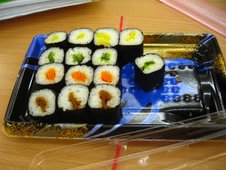Introduction to Vegan Japanese Food
Being vegan in Japan is very difficult. In fact, you will probably be told countless times that it is impossible; it is not. It requires some planning ahead, some adjustment to your usual daily menu, and some (ok a lot of) cooking. In general, you will probably find yourself cooking almost every meal. Your mortal enemy will be a little thing called katsuo (translated as bonito flakes, though I'm not sure why because as a native English speaker the term "bonito flake" means nothing to me.) It's easy to be a so-called "vegetarian who eats fish" but fish is in almost everything produced or consumed in this country.
For on the run options, here's what's probably available at your local grocery store or conbini:
Inari Zushi: Deep fried tofu pockets seasoned with sugar and soy sauce and filled with seasoned white rice. Be aware that these sometimes contain things other than plain white rice. Usually these things are just vegetable (as in the gomoku variety) or sesame seeds, but occassionally they may contain fish or fish products.
Onigiri: Rice triangles filled with something and covered in nori. There are two "somethings" that are ok for vegans: konbu (seaweed) and ume (sour plum--also called "Japanese apricot"). I have never seen an onigiri of these two flavours that was not vegan. The konbu one usually has a green or light green label and will say konbu in hiragana (こんぶ). The ume one's label often features a picture of a little red pickled plum along with the kanji 紀州梅 or just 梅. Sour plum is, well, sour and a lot of foreigners find they don't like this right away but try it anyway. It's my favourite onigiri.
Veg Sushi Rolls: Many varieties of vegetable sushi rolls are available. I like kanpyo the best (brown strips of marinated gourd--be careful there is a popular fish variety that is also brown and looks very similar. I always have to double check and make sure I know what I'm getting) but cucumber (kyuri), carrot (ninjin), daikon, and natto are also available.
Yasai Tempura: Delicious battered and deep-fried vegetables. Sometimes homemade tempura batter contains eggs but the variety sold (usually serve-yourself style) at most grocery stores tends to be vegan. Ask to be sure. Tempura is best when eaten with a bit of macha salt. Satsumaimo (Japanese sweet potato) and kabocha (pumpkin) varieties are my favourite!
Natto: Fermented soy beans. This stuff is sticky, foul smelling, and gross. Most foreigners don't like it but give it a try, you might be one of the rare ones who can stomach it and come back for seconds. Natto is apparently very healthy and stand alone is vegan. Watch out when it's served as it can be mixed with fish seasoning.
If you're checking out a Japanese restaurant (never my choice) you can't go wrong with plain white rice or salad with no dressing. Those are about the only things you can't go wrong with. Sometimes tsukemono (pickled foods) are ok but be sure to ask about katsuo who not infrequently makes an appearance in the brine.
Anpan: This is that white bun looking thing you see in a heating rack at the cash register of the conbinis. They come filled all kinds of things and only the an one is vegan. It's a bit strange and very hot! But sometimes good, especially if you're stuck.
Now on to my favourite part of Japanese cuisine: DESSERT!
Many sweets in Japan are made from rice flour and mashed sweetened beans so there are a LOT of vegan options on this front. Some of my personal favourites include:
Daifuku: Round cakes of rice flour (mochi) filled with sweetened adzuki bean paste (anko). These come in many colours and flavours, including plain white, strawberry pink, and yomogi (or grass) green. I like the yomogi ones the best all year round but in strawberry season, my favourite treat is one of the strawberry variety with a fresh, juicy strawberry in the very center!
Andama: Hard to find, but recently these are my favourite. Brownish purple balls made of anko that are a little hard and covered with a sugar frosting.
Karinto: Deep fried black sugar cookies. About the size and shape of your finger. They also come in a white sugar variety.
Jelly Cups: Often these tiny cups filled with a jello-like dessert are made from konnyaku, not gelatin. They come in many varieties and flavours. Check the label, if you see "ゼラチン" they're not vegan!
Anko Popsicles: I see these popsicles everywhere! They come in a red box or package and show a pink popsicle with red beans in it. They look a bit milky but, yup! they're vegan! There's also a mango popsicle I've seen with bits of konnyaku in it. There are also usually some sherbets or sorbets floating about that are vegan too. Check the labels you might find a summer treat in the freezer case! I have never seen the mythical IV soy ice cream I heard about from the Vegan Ronin. For 2 years I have looked in every freezer case I have come across, but if you can find it, try it! Let me know how it is!
Dango: Dango just means mochi ball served on a skewer and these come with a few different coatings or toppings. Maybe the most common is mitarashi dango with a delicious sweet soy sauce based glaze.
Experiment and let me know what you think!



